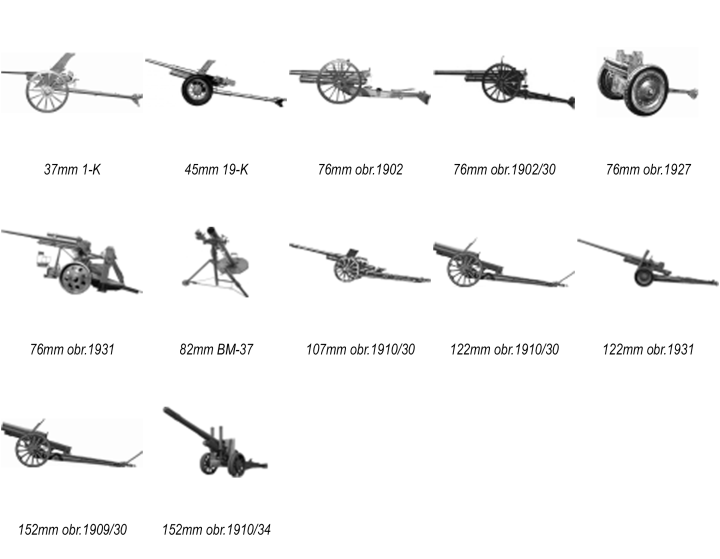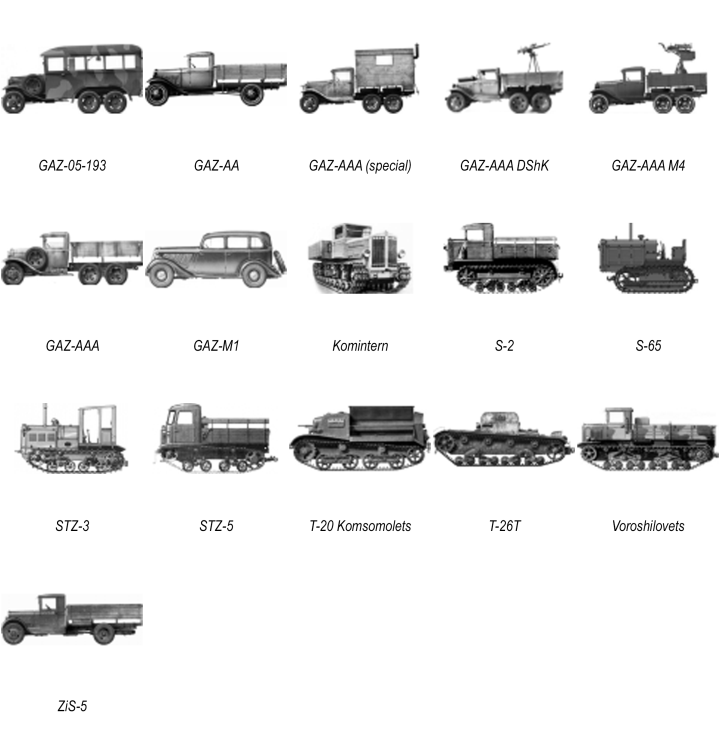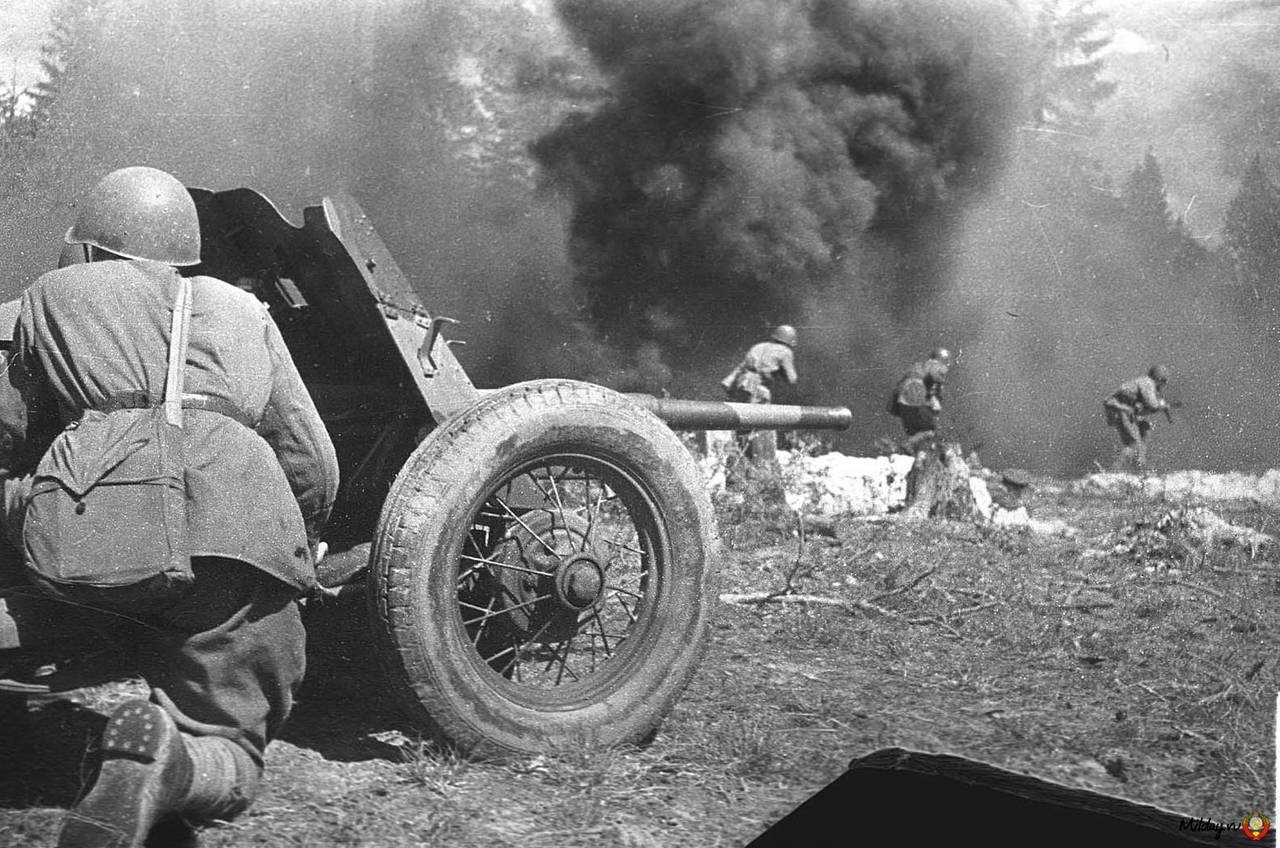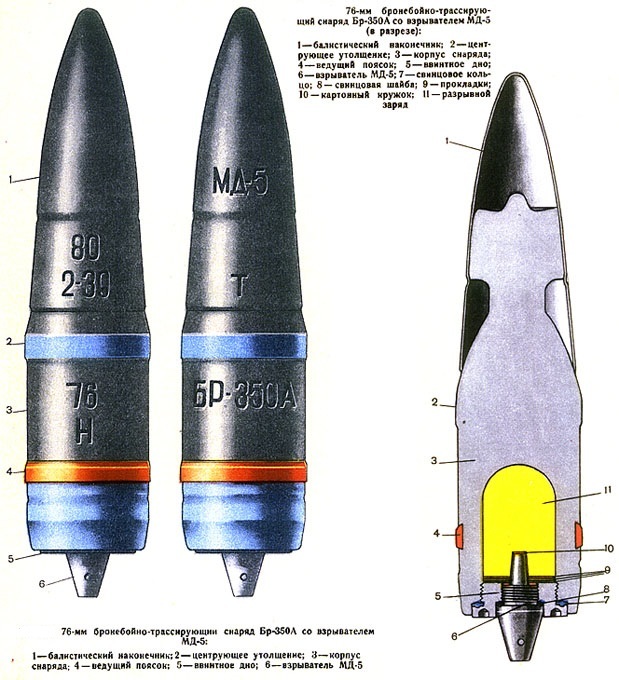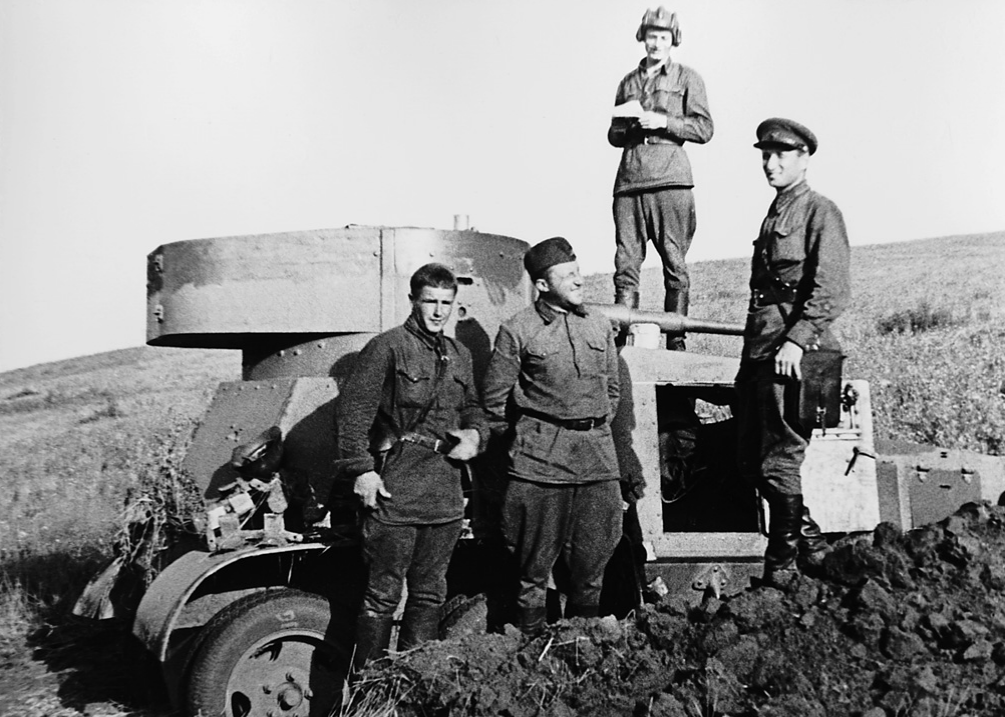 Soviet BA-6 medium armored car and its crew, supposedly of 7th Armored Brigade, Khalkhin-Gol area, 1939.
Soviet BA-6 medium armored car and its crew, supposedly of 7th Armored Brigade, Khalkhin-Gol area, 1939.Intro
If any of you guys do remember Norm Koger's TOAW PC wargame popular in late 90s and early 2000s, then you may also have played his Nomonhan'39 scenario. This scenario was very well designed and very interesting to play (even though it was quite annoying mid-game to click through 25 turns of a cease-fire intended to simulate a supply shortages).
What you probably don't remember, though, is that there were three Soviet mechanized formations in the scenario: 7th, 8th and 9th Mech Brigades. Each brigade was assigned with three motorized rifle battalions, also three tank battalions (27 T-26 light tanks each), a recon company (9 armored cars), a mortar battalion (24 mortars) and an artillery battalion (18 guns).

This actually makes sense, right? Back at the time Norm couldn't possibly find any reliable references about the composition of these formations, and "Nomonhan" book (by Alvin Coox, the primary source of Norm's inspiration) was portraying these brigades as mechanized formations. So he have made some educated guess and designed them as if they were mech brigades in a WW2 sense, mixing some motorized infantry, infantry support tanks, and artillery.
This composition may make sense, but it is rather far from reality. These three formations weren't a mechanized infantry (in the WW2 meaning) at all, but rather an armored cavalry, having a very specific purpose and organization.
And this is where our story begins.
Soviet Armored Cars of Interwar Period
In the early 30s, Red Army was on the rise. Among the fruits of Soviet industrialization (accompanied by the severe famine of 1932-1933, when 5..8 millions Soviet people lost their lives) were hundreds of new planes, tanks and armored cars of domestic production.
BA-27 became the Soviet first armored car design. Being a typical post-WWI 4x2 armored car, BA-27 featured 37mm short-barreled gun and a machinegun, some decent armor (7mm thickness was pretty good at the time) and some sloping of the front plates, but it also was clearly underpowered (a Soviet copy of FIAT 53A engine was capable of 35 hp only) and rather slow. Over 200 these armored cars were produced in 1928-1931, when more advanced designs were adopted.
 A column of BA-27 (leading) and BA-I armored cars
A column of BA-27 (leading) and BA-I armored carsBA-I became a significant improvement over BA-27. Having the same armament (an additional bow machinegun was only a marginal improvement) as BA-27, it was featuring new 6x4 Timken chassis combined with Ford Model AA engine. The new chassis, known as GAZ-AAA in Soviet Union, allowed BA-I to reach 75 kph (which was nearly twice as much as 40 kph of BA-27) and increase armor thickness up to 8 mm. Over 100 of these armored cars were produced in 1932-1934.
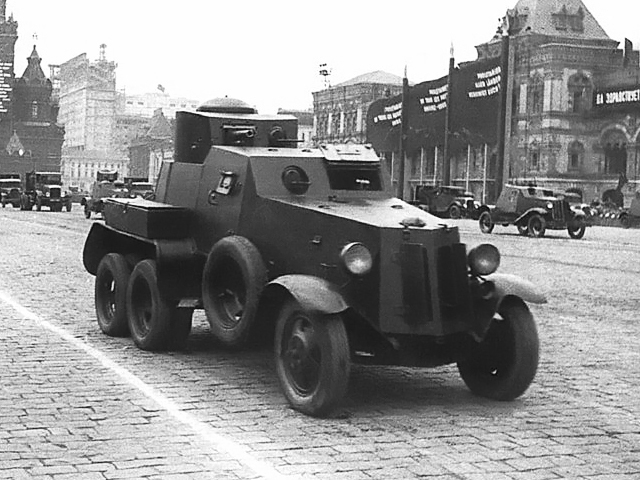 BA-I at the Red Square
BA-I at the Red SquareAs the mobility of BA-I was improved, its armament became obsolete already. 37mm short-barreled gun may have been sufficient at the time of WWI and in 20s, but it was clearly an outdated design by 30s. The combination of BA-I hull with the light tank turret (designed same as that of T-26, but with a thinner armor of 8mm compared to 15mm of T-26), featuring new 45mm rapid-firing gun, was designated BA-3. About 200 these armored cars were produced in 1933-1935.
BA-6 was basically a minor improvement (featuring a thicker 9mm front plate and no escape door in the back) over a BA-3. It was produced in 1936-1938 with almost 400 cars built (twice as more as BA-3). Its performance and combat capabilities were identical to those of BA-3, though.
 Turkish BA-3
Turkish BA-3 BA-6
BA-6At the same time, several light armored car types were designed and produced. D-8 (and its improved version D-12) were build upon GAZ-A (license-built Ford Model A) chassis and featured one (D-8) or two (D-12) machineguns. These armored cars were light enough to be air-transportable. A total of 62 D-8/12 were produced in 1931-1932, until they were replaced in production by FAI.
FAI had worse armor (6mm vs 7mm of D-8/12) and the same 4x2 GAZ-A chassis, but its main feature was the MG turret that was a significant improvement over D-8 and its MG fixed either in the bow or in the rear firing position. FAI was produced in 1933-1935, and also in 1938-1939 there was also an improved version FAI-M produced, featuring new GAZ-M1 - a licensed Ford Model B - chassis with a more powerful 50 hp engine. About 700 FAI and FAI-M were produced in total.
 D-8 (front) and D-12 (back) armored cars
D-8 (front) and D-12 (back) armored cars D-8 is being installed under the belly of TB-3 heavy bomber
D-8 is being installed under the belly of TB-3 heavy bomber FAI armored car featuring railroad wheels
FAI armored car featuring railroad wheelsThe latest and the most advanced Soviet mass-produced armored cars available by 1939 were medium BA-10 and light BA-20 armored cars.
The main improvements of BA-10 over BA-6 were thicker hull and turret armor (10 mm) and new conical turret design (featuring some sloping). The combat weight and max speed were nearly the same as of BA-6, however the 45mm gun ammo loadout was slightly reduced.
Being a relatively good design, BA-10 was produced in massive numbers, with a total of 3400 armored cars built in 1938-1941 (BA-10 and improved BA-10M combined).
 BA-10 armored car
BA-10 armored carLike BA-10 was an improvement over BA-6, new light BA-20 armored car was an improvement over FAI. It had similar (to FAI) design, but a much better GAZ-M1 chassis. Its modified version BA-20M featured much thicker frontal armor (9mm against 6mm of BA-20). Over 2000 of these armored cars were produced in 1936-1942.
 BA-20 armored cars, Khalkhin-Gol
BA-20 armored cars, Khalkhin-GolSoviet armored cars of the interwar period may be qualified as very well armed. Their 45mm 20-K gun - combining good RoF with decent penetration and powerful fragmentation shell - was one of the most powerful weapons ever installed on a pre-WW2 armored car, but this was probably their only advantage.
All Soviet cars were lightly armored vehicles. 8-10mm armor would be good at the time of their appearance in early 30s, but there were already better protected designs by late 30s. But, most importantly, their 4x2 and 6x4 chassis, driven by their weak (50 hp at best) engines meant they are bound to the road network and rendered them inadequate for cross-country reconnaissance and liaison duties.
In general, Soviet armored cars were clearly superior to Polish, Japanese, US and British designs of the time, but at least Germany and France had some superior designs.
For example, German SdKfz.231 (6-rad) introduced yet in 1932 had the same 6x4 wheel scheme, same 8mm armor and weaker armament, but it also featured much better engine (75 hp vs 50 hp of BA-6/10).
But then there was also SdKfz.231 (8-rad) introduced in 1936 (same year as BA-6), featuring extremely powerful 150 hp engine, 15mm frontal armor and 8x8 drive. It was superior to Soviet armored cars in every aspect except (arguably) armament, and was generally a much better scout platform than any Soviet design.
Also French Panhard 178 had much better armor (18-13mm), much better engine (105 hp) and better full-drive 4x4 chassis than those of Soviet armored cars.
There was one aspect, however, where Soviet armored cars outclassed all their opponents. Not great, not terrible, but there were thousands of them produced, and that was the world's biggest arsenal of armored cars. Having only 58 light and 224 medium armored cars as of January 1st, 1934, seven years later the Red Army had already 4325 armored cars (light and medium combined) by December 1st, 1940.
Majority of them will be lost next year during Operation Barbarossa, where the whole regular Red Army was nearly annihilated together with all its armored vehicles. But at the time of Battle of Khalkhin-Gol, summer 1939, Soviet armored cars were still on the rise.
Historical Organization
Designed for reconnaissance and liaison duties, most of Soviet armored cars were assigned to reconnaissance squadrons/companies and reconnaissance battalions (where most of the medium armored cars would be normally found), as well as to various signal units (where most of light armored cars would be used).
For example, a wartime rifle division's reconnaissance battalion (table of organization #04/825, adopted January 27th, 1938) would have an armored car company of 10 medium armored cars (a single radio-equipped car of company CO and three armored car platoons consisting of a single radio-equipped car and two regular cars each). Signal battalion of the same rifle division (table of organization #04/826) would have two radio-equipped light armored cars in the staff company.
Reconnaissance battalion of a light tank brigade (table of organization #010/922) would have 14 medium and 5 light armored cars: two radio-equipped medium cars in battalion's staff platoon and another 12 medium (of them 4 radio-equipped and 8 regular cars) and 5 light (of them one radio-equipped) in armored car company.
Also cavalry divisions had armored car squadrons, of course, as well as motorized infantry brigades had their own recon squadrons, too.
However, there were also rather special kinds of units - armored brigades. More specifically, if translated literally from Russian, they are "Motorized-Armored Brigades", but we will use "Armored" for simplicity.
The creation of these units was inspired by the very special conditions of Mongolian stepps, where the road network was very poor at best, but the cross-country soils are (generally) solid and flat enough for an armored car to go offroad. The type of a terrain meant an armored car - even a relatively underpowered Soviet one - is no more bound to the road network and may operate freely, as a light tank, but with a better operational mobility because armored cars are easier to drive and easier to maintain than tanks, meaning they could also cover large distances in a shorter times than tank units.
The latter also sounded great for a vast Mongolian theater, where the relatively small Soviet expeditionary forces had to cover a huge territory. So it became clear that, at least in Mongolia, it would make a perfect sense to create bigger armored car units rather than just recon companies and liaison detachments.
The first of its kind, 20th Light Mechanized Brigade was created in 1933. The brigade, among other units, had 20th Armored Car Battalion, which became the first battalion-sized armored car unit of the Red Army. The brigade was created especially for Mongolian theater and proved to be quite effective, so in 1936 it was reorganized into Special Armored Brigade and Special Armored Regiment. Later that year additionally 7th Armored Brigade was created at Ural and next year relocated to Mongolia, too.
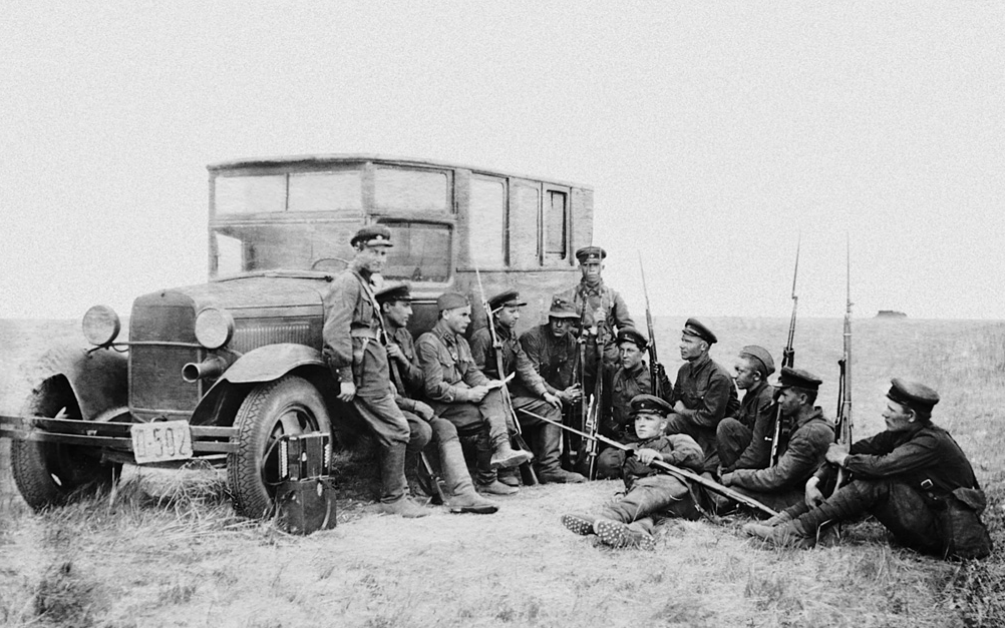 Soldiers of a rifle-machinegun battalion of 9th Armored Brigade near their GAZ-AA staff bus
Soldiers of a rifle-machinegun battalion of 9th Armored Brigade near their GAZ-AA staff busFinally, in 1938 the new ToE was adopted for armored brigades (tables of organization #16/720-16/727), so all three armored car units in Mongolia - 7th Bde, Special Bde and Special Rgt - were reorganized to fit these new unified ToEs. Special Brigade became the 9th Armored Brigade, and the Special Armored Regiment was reorganized into 8th Armored Brigade. Next year all three units - 7th, 8th and 9th Armored Brigades - took part in Khalkhin-Gol conflict.
Each brigade consisted of:
- HQ,
- one armored car battalion,
- one recon battalion,
- one rifle-machinegun (motorized) battalion,
- signal company,
- combat support company,
- repair company,
- truck platoon.
8th Armored Brigade had also a tank battalion (BT tanks).
So, as you can see, these armored brigades were nowhere near "true" WW2-era mechanized brigades: they didn't have any medium artillery, nor they had enough infantry to attack the fortified position or defend a line.
What they resemble is just a scaled up (3x times) recon battalion - and this is actually what they were.


 Commanders of 7th, 8th and 9th Armored Bridages at Khalkhin-Gol (left to right, respectively): Maj A.Lesovoy, Maj V.Mishulin and Maj S.Oleynikov
Commanders of 7th, 8th and 9th Armored Bridages at Khalkhin-Gol (left to right, respectively): Maj A.Lesovoy, Maj V.Mishulin and Maj S.OleynikovAll three brigades were actively engaged during the first period of Khalkhin-Gol conflict.
Armored cars of 9th Armored Brigade took an active part in repelling the first and the only major Japanese tank attack during the conflict (2nd - 3th July). Soviet rapid-firing 45mm guns were far superior to Japanese 37mm and 57mm tank guns, also Soviet crews have been firing from hull-down positions, so after two hours of intensive fight a single company of 12 BA-10s had destroyed 10 Japanese tanks without any casualties from their side. Another Japanese tank was trapped in the barbed wire and was captured by Soviet armored car crewmen.
At the same time, armored cars of 7th Armored Brigade were engaged in furious counter-attack at Bain-Tsagan Mountain on July 3rd. Here Soviet armored cars had to attack Japanese defensive positions without artillery or infantry support. Predictably, this didn't end well. As 1st Lt K.Petrov, an Aide of 247th Armored Car Battalion's Chief of Staff described:
As the battalion was approaching Bain-Tsagan Mountain, I saw 4-5 armored cars of 1st and 2nd Companies started to burn. More and more cars were catching fire, so the vehicles from rear lines started to turn around and retreat... 3rd Company lost just one armored car, because they saw burning vehicles of other companies in front of them, so they didn't go forth. BA-6 of 9th Armored Brigade, captured by Japanese army in July.
BA-6 of 9th Armored Brigade, captured by Japanese army in July.During that attack Soviet troops (11th Tank Brigade and 7th Armored Brigade combined) have lost 37 armored cars out of 59 engaged that day (in other words, 2/3 of armored cars were either disabled or destroyed). There Soviet armored car crews have learned a deadly specifics of BA-6 and BA-10 designs: there was a fuel tank located in the upper part of the hull, above the heads of a driver and machinegunner. When penetrated and ignited, these fuel tanks poured liters of burning fuel, with a very little chance for those two crew members to survive the deadly napalm flow.
Overall, the combat performance of armored brigades was summarized in one Soviet document dated July 1939 like this:
"Armored units - 7th, 8th and 9th Armored Brigades - are just an armored cavalry, better suited for border patrols and internal security duties. They were not trained to fight as an infantry and they aren't able to do that. These units played important role during the early stages of the conflict. Now they have received a lot of conscripts and do require an extra time for training."
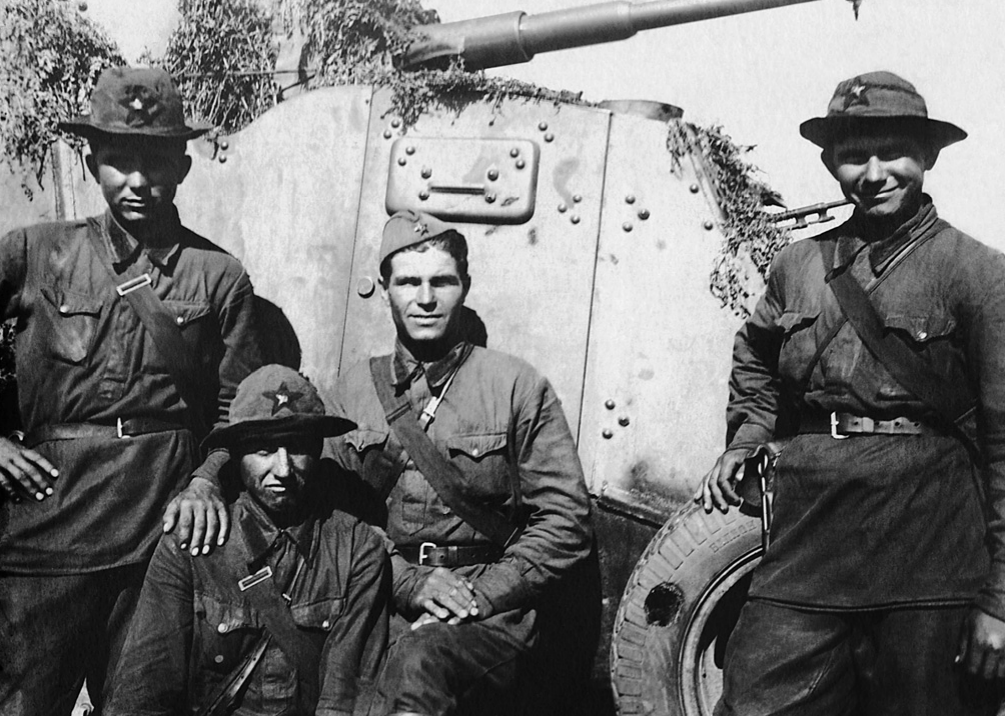 BA-10 armored car commanded by P.Moroz (first from the right), 9th Mechanized Brigade.
BA-10 armored car commanded by P.Moroz (first from the right), 9th Mechanized Brigade.CmdOps Organization
Gathering all the information necessary to properly model these units in Command Ops was not that easy. Although high-level ToE of these brigades is nowadays well known and available in the literature (f.ex.
here), some critical details were still missing. As we model company- and platoon-level warfare in CmdOps, you need to know the ToE down to that level.
 An authentic Soviet organizational chart for an Armored Brigade, tables of organization #16/720-16/727
An authentic Soviet organizational chart for an Armored Brigade, tables of organization #16/720-16/727Looking for answers, we went to Russian archives. After several months of research in Russian State Military Archive, Moscow, we have found plenty of organizational information, as well as a lot of actual documents concerning ToEs and equipment, losses and actions of Soviet units during the Khalkhin-Gol conflict.
 An authentic Soviet report, describing the available equipment and combat vehicles of 9th and 8th Armored Brigades, June 1939
An authentic Soviet report, describing the available equipment and combat vehicles of 9th and 8th Armored Brigades, June 1939This information, together with a common historical literature, allowed us to model these units as precise as we would want them to be.
(Well, actually, to secure the future of East Front development, we have found and copied literally thousands of pages of Soviet organizational charts and authentic tables of organization, but most of that stuff will only be used in future DLCs).
 A company of a Recon Battalion (table of organization #16/723). This one has BA-10 medium armored cars assigned, so it will be used to model the 240th Recon Battalion of 9th Armored Brigade
A company of a Recon Battalion (table of organization #16/723). This one has BA-10 medium armored cars assigned, so it will be used to model the 240th Recon Battalion of 9th Armored BrigadeAnother thing, which you may find unusual about Khalkhin-Gol DLC, is that now all small arms has anti-tank capability. We have introduced an armo-piercing firing type to all the small arms including bolt action rifles and LMGs. Of course, they are only marginally effective, as you can only penetrate like 6-7mm of armour at the point blank range of 100 meters. However, this is more than enough to kill a thinly armored Soviet FAI armored car or a SU-12 SP-gun, wandering too close to your position. Unlike other WW2 DLCs, Khalkhin-Gol will feature several such a lightly armored vehicle types.

That's all for now guys, because this devblog is already too big to be readable. Have a nice evening, sorry for my bad English and see you next time.






 Soviet BA-6 medium armored car and its crew, supposedly of 7th Armored Brigade, Khalkhin-Gol area, 1939.
Soviet BA-6 medium armored car and its crew, supposedly of 7th Armored Brigade, Khalkhin-Gol area, 1939.
 A column of BA-27 (leading) and BA-I armored cars
A column of BA-27 (leading) and BA-I armored cars BA-I at the Red Square
BA-I at the Red Square Turkish BA-3
Turkish BA-3 BA-6
BA-6 D-8 (front) and D-12 (back) armored cars
D-8 (front) and D-12 (back) armored cars D-8 is being installed under the belly of TB-3 heavy bomber
D-8 is being installed under the belly of TB-3 heavy bomber FAI armored car featuring railroad wheels
FAI armored car featuring railroad wheels BA-10 armored car
BA-10 armored car BA-20 armored cars, Khalkhin-Gol
BA-20 armored cars, Khalkhin-Gol Soldiers of a rifle-machinegun battalion of 9th Armored Brigade near their GAZ-AA staff bus
Soldiers of a rifle-machinegun battalion of 9th Armored Brigade near their GAZ-AA staff bus

 Commanders of 7th, 8th and 9th Armored Bridages at Khalkhin-Gol (left to right, respectively): Maj A.Lesovoy, Maj V.Mishulin and Maj S.Oleynikov
Commanders of 7th, 8th and 9th Armored Bridages at Khalkhin-Gol (left to right, respectively): Maj A.Lesovoy, Maj V.Mishulin and Maj S.Oleynikov BA-6 of 9th Armored Brigade, captured by Japanese army in July.
BA-6 of 9th Armored Brigade, captured by Japanese army in July. BA-10 armored car commanded by P.Moroz (first from the right), 9th Mechanized Brigade.
BA-10 armored car commanded by P.Moroz (first from the right), 9th Mechanized Brigade. An authentic Soviet organizational chart for an Armored Brigade, tables of organization #16/720-16/727
An authentic Soviet organizational chart for an Armored Brigade, tables of organization #16/720-16/727 An authentic Soviet report, describing the available equipment and combat vehicles of 9th and 8th Armored Brigades, June 1939
An authentic Soviet report, describing the available equipment and combat vehicles of 9th and 8th Armored Brigades, June 1939 A company of a Recon Battalion (table of organization #16/723). This one has BA-10 medium armored cars assigned, so it will be used to model the 240th Recon Battalion of 9th Armored Brigade
A company of a Recon Battalion (table of organization #16/723). This one has BA-10 medium armored cars assigned, so it will be used to model the 240th Recon Battalion of 9th Armored Brigade
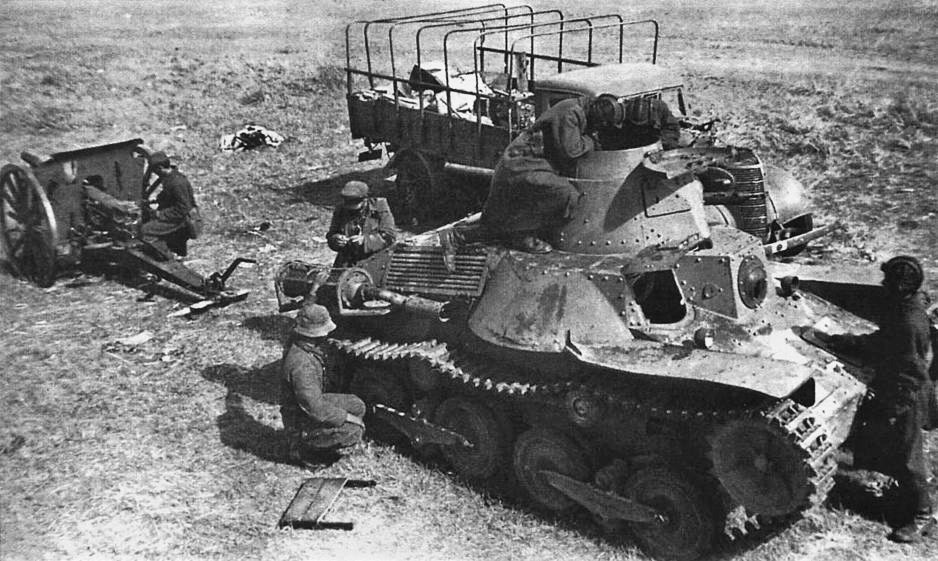 Soviet soldiers and tankers inspect captured Japanese equipment
Soviet soldiers and tankers inspect captured Japanese equipment


